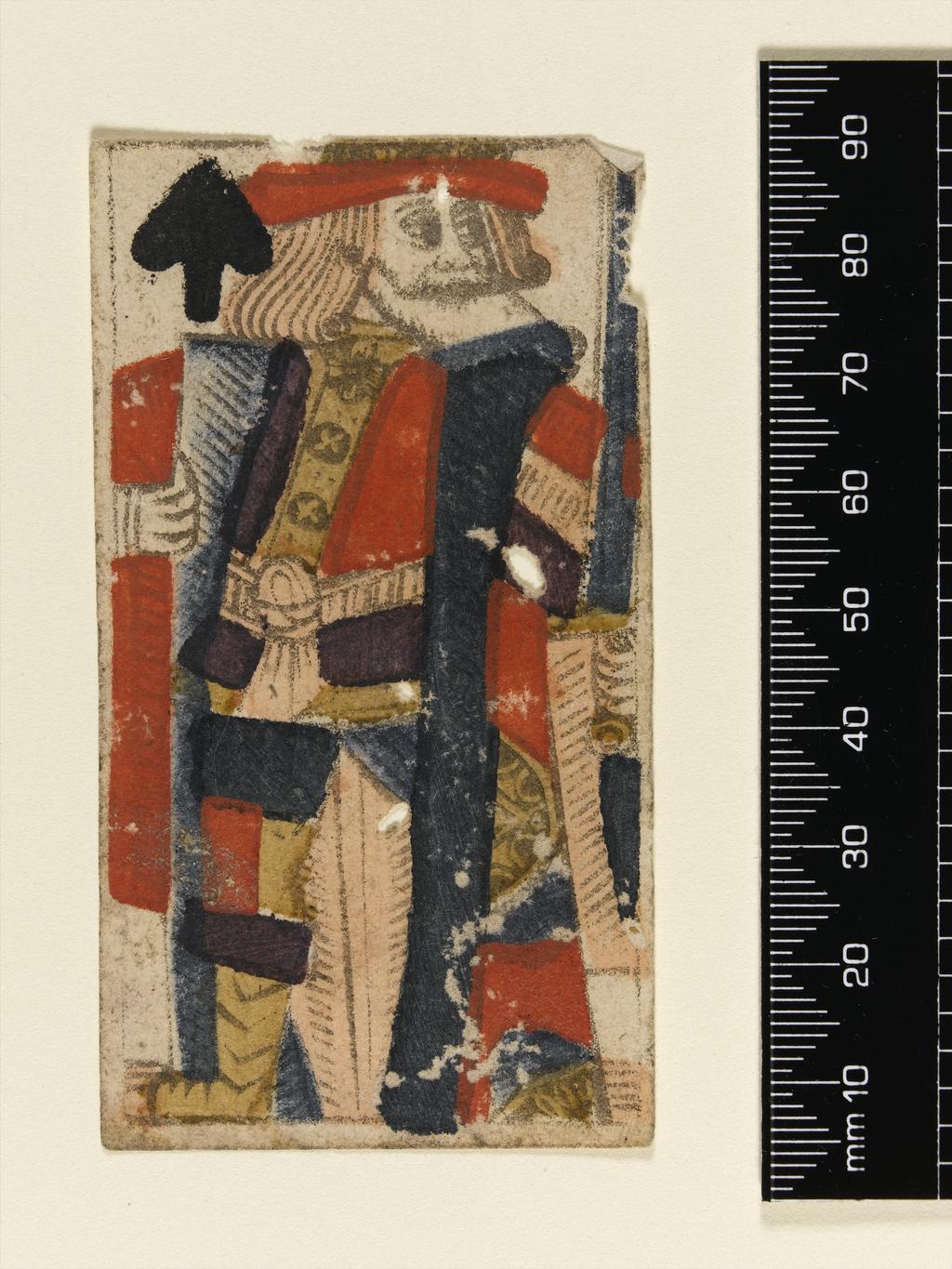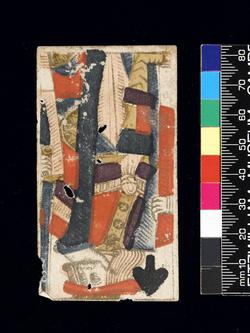Current Location: In storage
Titles
King of Spades
Maker(s)
Printmaker:
Unknown
Printmaker:
Marechal, Pierre
(After)
Entities
Categories
Description
The bearded king stands facing front, his head turned towards the right. His right hand holds his robes to the left and his left hand holds aloft a sword to the right. The pip is located at upper left. A border is printed around the figure. The design is generally compressed, the crown barely there at all. There are losses to the paper support.
Legal notes
Given by Walter Morley Fletcher, 1907
Acquisition and important dates
Method of acquisition: Given
(1907)
by
Fletcher, Walter Morley
Dating
16th Century
Circa
1567
CE
-
Circa
1599
CE
Note
Woodcut printed and stencilled playing card of the Rouen pattern. A narrow card cut from a larger sheet of thin, laid paper and with some blank cards of heavier weight. Coloured in red, black, golden brown, dark blue, light blue. From a group of ten playing-cards, one of two apparently identifiable but incomplete packs, 'each representing parts of more than one original pack of the same kind' (See Fletcher, 1907, p.455) which were found at Trinity College, Cambridge by Walter Morley Fletcher in the Summer of 1902 during repair work to staircase A, which led to Fletcher's rooms in the north-west corner of the Great Court (See P.15012-R(1)-(8) for the second pack discovered by Fletcher at Trinity). Fletcher published his findings in the journal of the Cambridge Antiquarian Society: 'On Some Old Playing-Cards Found in Trinity College', Proceedings of the Cambridge Antiquarian Society, XI, no. 3 (Cambridge, 1907), pp. 454-464. In the article, Fletcher describes the group as: 'Eleven cards of inferior make. Uniform size 3 3/8 in x 1 3/4 in. Each card built of three sheets. Of Hearts, the ten; of Spades, the king, ten and eight; of Diamonds, the king, three nines, two eights; of Clubs, the nine only'. An old curatorial pencil annotation in the margin of the Fitzwilliam copy of the article indicates the fact that only two of the three Nine of Diamonds listed came to the Museum, meaning that there are only ten and not eleven cards in this group. The large number of loose, blank sheets indicates that the layered construction of the cards has deteriorated since Fletcher made his discovery at Trinity College in 1902. There are now only three examples of cards built from just two sheets pasted together: Eight of Spades, Eight of Diamonds, where the second sheet is no longer adhered but which was formerly evidently the case, as ink from the top sheet has transferred, and a blank card. There are seventeen additional loose, blank sheets of varying thickness, including one which is inscribed in ink with the name: 'Morris de W. / Vanderli[s]', which, according to Fletcher, is not listed in University records or in the list of members of Trinity College's foundation from 1635. The inscribed sheet, Fletcher says, was originally 'upon the back of one of the cards'. See Notes. Fletcher attributes these cards to Rouen card maker Pierre Maréchal or 'a very close follower of his at Rouen or in England' and their date to 'the last half of the 16th century.' (Fletcher, 1907, p.463). Fletcher bases his attribution to Maréchal on comparison of one of the kings to the pack by Maréchal, c.1567, which is generally acknowledged as the model from which the English pack evolved; see http://www.wopc.co.uk/mounthood/mareschal. Fletcher doesn't state which king he is comparing and contradicts his earlier information about there being two kings, this noted in a curatorial annotation in the margin of the Fitzwilliam copy of the article. He claims that there is 'a very exact likeness to the same king of a pack by Maréchal', but in fact there are many differences in detail and colouring when comparing both the King of Diamonds and the King of Spades in the Fitzwilliam group to those in the original Maréchal pack. The British Museum has a King of Spades 'similar to those produced in Rouen by Pierre Mareshal circa 1565' which is one of a pair of court cards found behind panelling at Hampton court in 1936 and which is attributed to an unknown printmaker of the late 16th century, and with manufacture located in Rouen not England. See BM 1936,0731.1-2. A more recent article on the Fitzwilliam cards by Michael Goodall notes the comparative lack of detail from the Maréchal originals and locates their production in England rather than France: 'Their size and relatively crude design possibly means that they were printed in England rather than in Rouen'. See Goodall, 2003, p.196.
School or Style
British

 IIIF Manifest
IIIF Manifest




